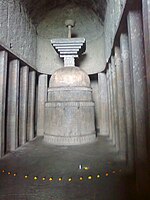Bedse Caves
This article needs additional citations for verification. (November 2021) |
| Bedse Caves | |
|---|---|
Pune District, Maharashtra, India | |
| Geology | Basalt |
| Difficulty | easy |
| Pronunciation | Bedse or Bedsa |
Buddha's Holy Sites |
 |
Bedse Caves (also known as Bedsa Caves) are a group of
There are two main caves. The best known cave is the
Chaitya
Cave 7, the chaitya hall, is reached by a long narrow passage into the rock. The front
An inscription on one of the gate arches reads: Gift of Pushyanka, son of Ananda Sethi from Nashik.

Vihara
The vihara at Cave 11 has a rather unusual form, with a main chamber shaped somewhat like a chaitya, with a rectangular plan with a rounded apsidal far end, and a vaulted roof. This is now open to the outside, but presumably originally had a wooden screen. Around the chamber are nine doors to cells, each with a relief chaitya-arch surround. Friezes with railing patterns run round the room at two levels. There are four further cells outside where the screen would have been.[6]
Other
There is also a small stupa outside to the right of the main caves. Until around 1861 the caves were regularly maintained - even painted. These works were ordered by local authorities in order to please British officers who often visited caves. This has caused loss of the remnants of plaster with murals on it.
Visiting
Both caves face eastwards so it is recommended to visit the caves in the early morning, as in sunlight the beauty of carvings is enhanced.
Bedse Caves can be reached from Pune via Kamshet. Upon reaching Kamshet Chowk, left route is to be taken. That route goes straight to Bedse Village where the caves are located. They can also be reached via Paud - Tikona Peth - Pawananagar. Alternate route is from Somatne-Phata on the Pune-Mumbai NH4 Highway.
Bedse Caves are comparatively less known and less visited. People know about the nearby
The best time to visit Bedse Caves is the rainy season as the hills are filled with lush greenery during that time. Also many small waterfalls are created that can only be enjoyed during the rainy season. As this is one of the lesser known spots, not many tourists throng the place, so makes it easy to enjoy the views.
Gallery
-
General view, with the top of the chaitya entrance columns visible, and the outside stupa
-
Entrance to the Chaitya Hall
-
Columns at chaitya entrance
-
Capital of a column above the main entrance
-
Capitals
-
Side wall inside the chaitya verandah
-
Peepal leaves on gavaksha arches
-
The stupa in the chaitya
-
Floral Carving over chaitya doorway
-
Inscription in Brahmi: Gift of Pushyanka, son of Ananda Sethi from Nashik
-
Main vihara
-
Inside the vihara
-
Cell doorways off the vihara
-
Bedsa caves
Notes
References
- Harle, J.C., The Art and Architecture of the Indian Subcontinent, 2nd edn. 1994, Yale University Press Pelican History of Art, ISBN 0300062176
- Michell, George, The Penguin Guide to the Monuments of India, Volume 1: Buddhist, Jain, Hindu, 1989, Penguin Books, ISBN 0140081445














